Dekolink Wireless CBDAPG21W60 MW-CBDA-800A-1W60-PG2 User Manual Revised manual
Dekolink Wireless Ltd MW-CBDA-800A-1W60-PG2 Revised manual
Contents
- 1. Users manual
- 2. Revised manual
Revised manual
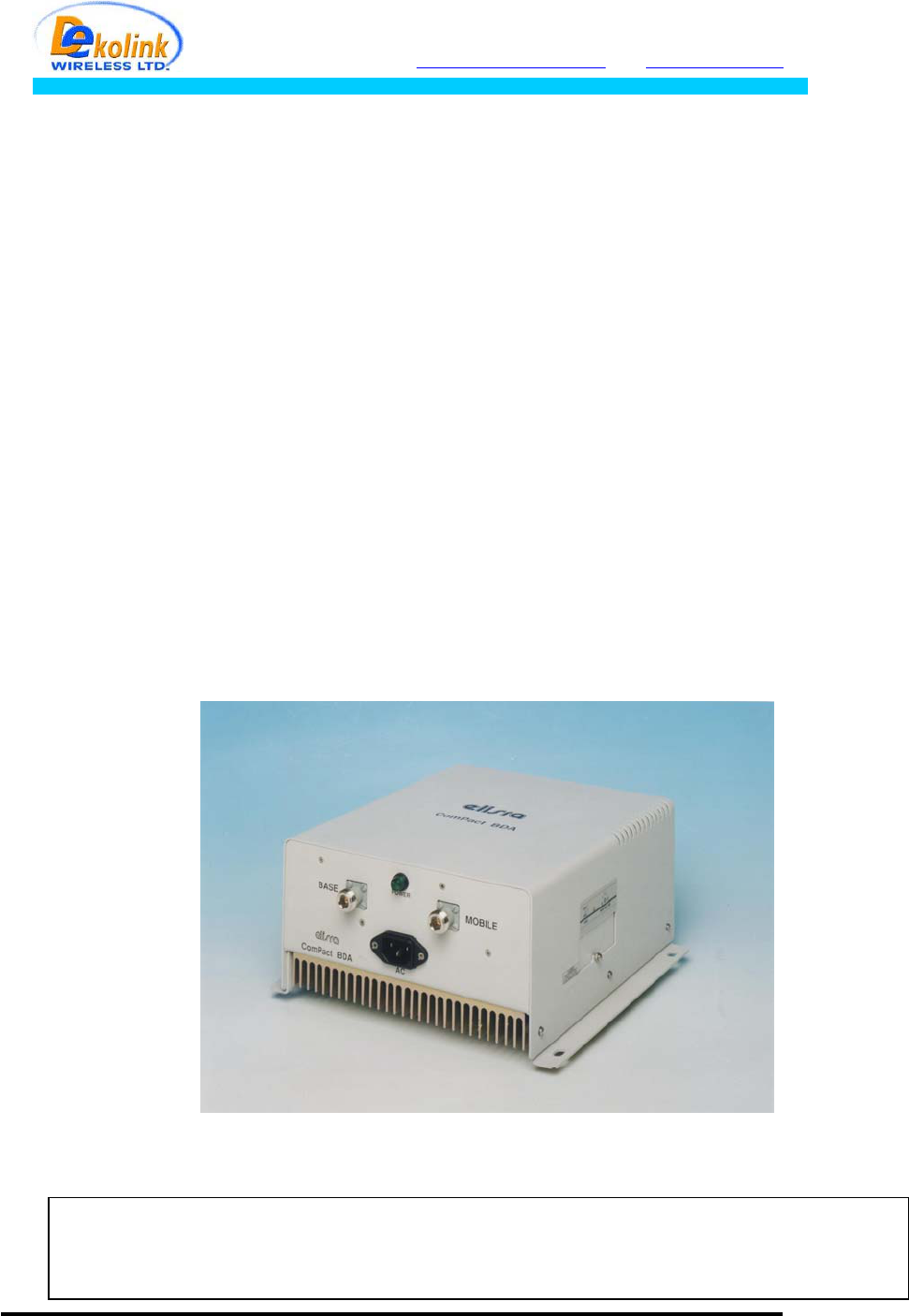
Dekolink WIRELESS Ltd.
16 Bazel St. Qiryat-Arieh Petah-Tikva, Israel, 49510
Tel- 972-3-9180-180 Fax-972-3- 190-9180
e-mail: marketing@dekolink.com web www.dekolink.com
INSTALLATION
AND
OPERATING INSTRUCTIONS
FOR
MW-CBDA-800A-1W60-PG2
CELLULAR BI-DIRECTIONAL AMPLIFIERS
Dekolink Wireless Proprietary and Confidential Information. Copying, Distribution, and Disclosure are
prohibited without Express Authorization from Dekolink Wireless Company.
This document is protected by all applicable copyright laws.
Page 1 of 13 CBDA-800A-1W60-PG2 INST2.doc REV. 0 09.03

Dekolink WIRELESS Ltd.
16 Bazel St. Qiryat-Arieh Petah-Tikva, Israel, 49510
Tel- 972-3-9180-180 Fax-972-3- 190-9180
e-mail: marketing@dekolink.com web www.dekolink.com
TABLE OF CONTENTS
PARAGRAPH PAGE No
BDA OVERVIEW 3
BLOCK DAIGRAM DESCRIPTION 4
BDA OPERATION 5
AGC & MGC FUNCTION 5
BDA INSTALLATION 7
BASE/DONOR ANTENNA INSTALLATION 7
REMOTE/SERVICE ANTENNA INSTALLATION 7
ANTENNA ISOLATION 7
INSTALLATION STEPS 8
DIAGNOSTICS GUIDE 9
ELECTRICAL SPECIFICATIONS 10
MECHANICAL SPECIFICATIONS 10
ENVIRONMENTAL CONDITIONS 10
RF EXPOSURE WARNING 11
LINITED WARRANTY 13
LIST OF DRAWINGS
DRAWING PAGE No
BDA BLOCK DIAGRAM DRAWING 3
BDA (WITH AGC) RF BLOCK DIAGRAM DRAWING 4
AGC & MGC CONTROL 6
MECHANICAL OUTLINE 12
Page 2 of 13 CBDA-800A-1W60-PG2 INST2.doc REV. 0 09.03
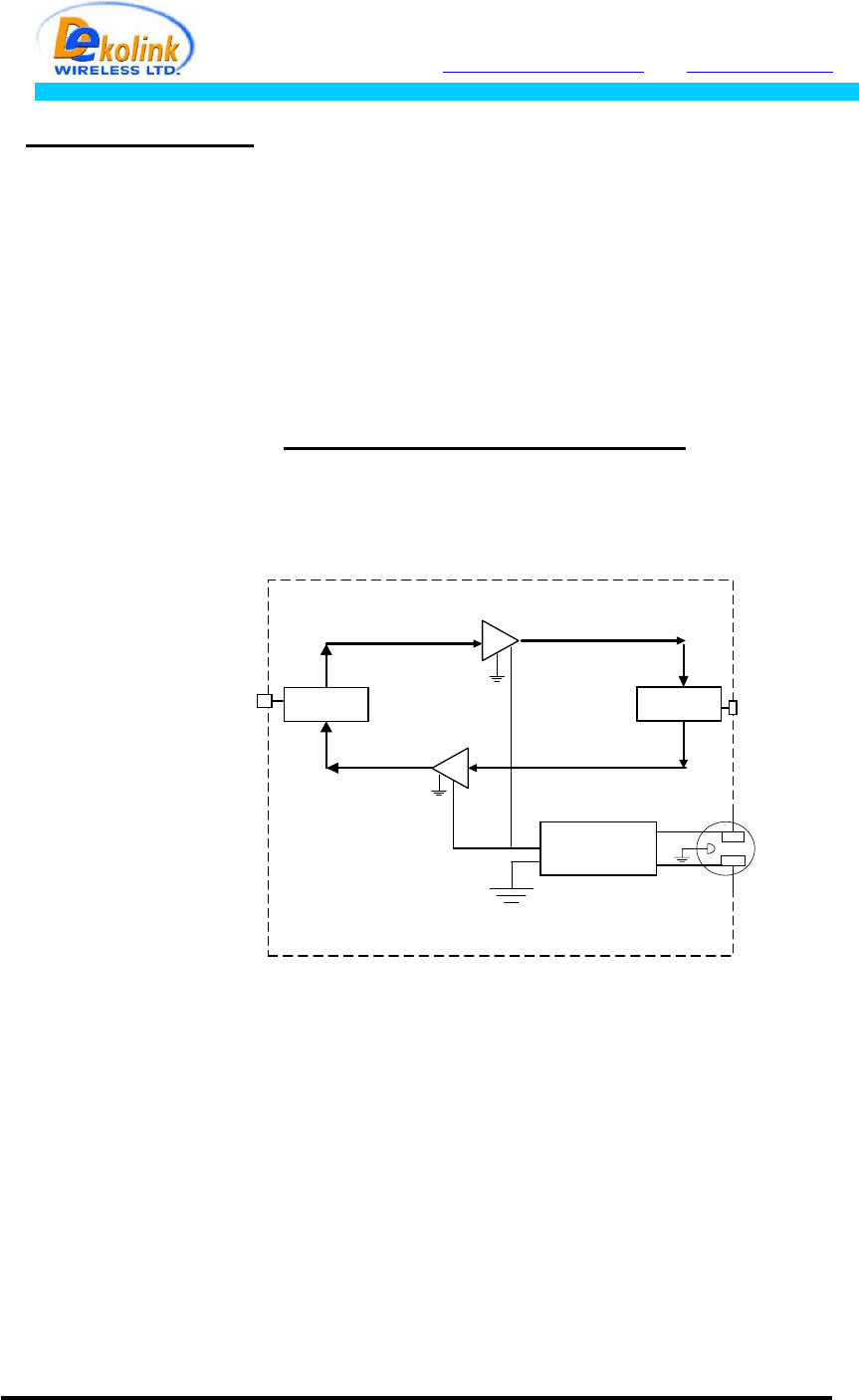
Dekolink WIRELESS Ltd.
16 Bazel St. Qiryat-Arieh Petah-Tikva, Israel, 49510
Tel- 972-3-9180-180 Fax-972-3- 190-9180
e-mail: marketing@dekolink.com web www.dekolink.com
BDA OVERVIEW:
The Bi-Directional Amplifier (BDA) assembly provides an exceptional repeater/booster performances to
extend the coverage area of radio communications in buildings and RF shielded environments.
Features such as high linearity power amplifiers are contributing for the overall improved system
linearity performances. The unit is based on a duplexed path configuration, having sharp out of band
attenuation for improved isolation between the receiving and transmitting paths.
BDA BLOCK DIAGRAM
Duplexer
RF
AMPLIFIER
Downlink
Duplexer
Uplink
RF
AMPLIFIER
TO
BASE
STATION
ANTENNA
TO
AREA
ANTENNA
POWER
SUPPLY
(N-TYPE)
(N-TYPE)
(STANDARD
3 WIRE)
INPUT AC
CONNECTOR
DC
Page 3 of 13 CBDA-800A-1W60-PG2 INST2.doc REV. 0 09.03
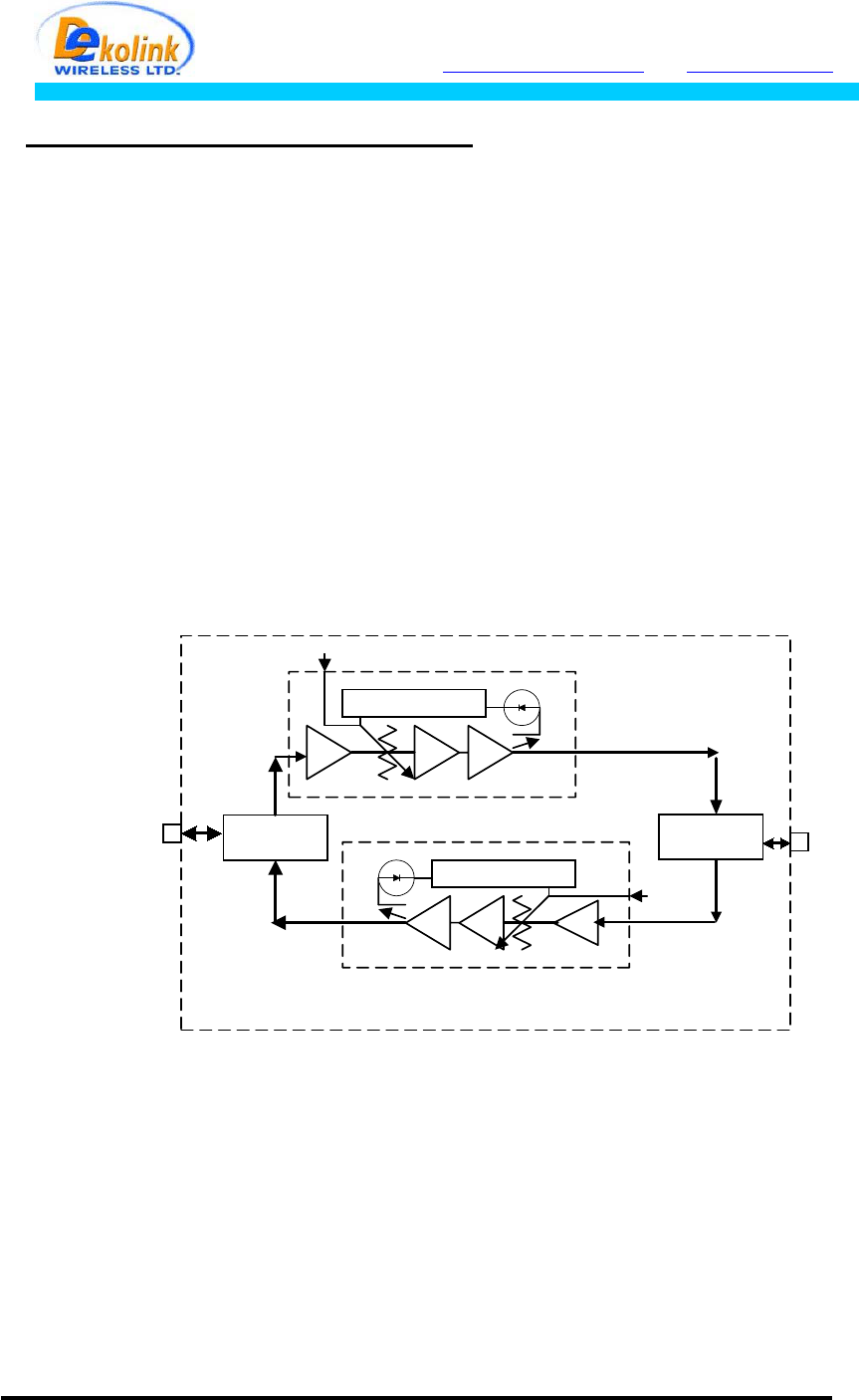
Dekolink WIRELESS Ltd.
16 Bazel St. Qiryat-Arieh Petah-Tikva, Israel, 49510
Tel- 972-3-9180-180 Fax-972-3- 190-9180
e-mail: marketing@dekolink.com web www.dekolink.com
BLOCK DIAGRAM DESCRIPTION:
The amplifiers in this BDA have an AGC option switch. When switched on, the AGC circuit limits the
amplifier output power. The AGC circuit senses the output power and introduces more attenuation,
when the output power exceeds the preset level of +27dBm*. This way the gain of the amplifier is
reduced, its output power is limited and the intermodulations products are kept below the desired level.
In this manner the output power cannot exceed the +27 dBm* preset power and the IMD levels are
always kept below –13 dBm.
The AGC amplifier has a Power LED lamp that illuminates when the output power has reached the
preset power limit.
*note: AGC preset level can be factory modified to +24dBm upon customer request.
In addition the BDA has a trimmer that enables the reduction of the gain by 15 dB.
Duplexer
Downlink
Duplexer
Uplink
TO
BASE
STATION
ANTENNA
TO
AREA
ANTENNA
(N-TYPE)
(N-TYPE)
AGC RF AMPLIFIER
AGC CIRCUIT
DETECTER
AGC CIRCUIT
DETECTER
AGC RF AMPLIFIER
COUPLER
COUPLER
MGC
MGC
BDA with AGC & MGC
RF BLOCK DIAGRAM
Page 4 of 13 CBDA-800A-1W60-PG2 INST2.doc REV. 0 09.03

Dekolink WIRELESS Ltd.
16 Bazel St. Qiryat-Arieh Petah-Tikva, Israel, 49510
Tel- 972-3-9180-180 Fax-972-3- 190-9180
e-mail: marketing@dekolink.com web www.dekolink.com
BDA OPERATION
The BDA comes with a standard 3-wire male plug with phase, neutral and safety ground wires. A high
efficiency DC switching power supply supplies DC power to two amplifiers (Uplink and Downlink) and
the Power On lamp.
The RF connection is made via two type “N” female connectors. The RF connector labeled “Base” must
be connected to the antenna pointing to the base station. The RF connection labeled “Mobile” must be
connected to the antenna pointing into the area to be covered by the BDA.
The isolation between the base station antenna and the mobile antenna should be at least 12 dB higher
than the BDA gain. If the isolation is less than the BDA gain, oscillation would start and would saturate
the amplifier. Isolation of few dB higher than the BDA gain cannot start oscillations but would causes
gain ripple in the band.
AGC & MGC FUNCTION
The BDA model No: MW-CBDA-800A-1W60-PG2 has AGC function. Their amplifier has a directional
coupler and a detector at the output of the high power amplifier to monitor the output power. When a
high signal is received the automatic level control detects the amplitude and sends a feedback signal to
a voltage variable attenuator, which attenuates the signal level so that the output power of the amplifier
does not exceed the preset limit. The LED on the amplifier illuminates when the power out the amplifier
is within the set limit (both when the AGC is On and when the AGC is OFF).
The switch on the RF amplifier enables the AGC function. If the AGC is disabled then the amplifier gives
maximum gain.
MGC: The RF gain of the BDA can be reduced linearly by about 15 dB using the trimmer on the
amplifier. The RF gain is at maximum when the trimmer is at anti-clockwise direction. To reduce the
gain, turn the trimmer clockwise using a screwdriver. Turning it halfway would reduce the gain by 7.5
dB.
The AGC and MGC functions for the uplink path are reached by opening a small cover located on the
DBA side adjacent to the Mobile antenna port. For the downlink path the window is located on the side
near the Base antenna port.
Note: The BDA is shipped with the AGC switch in the OFF position and maximum RF gain.
Page 5 of 13 CBDA-800A-1W60-PG2 INST2.doc REV. 0 09.03
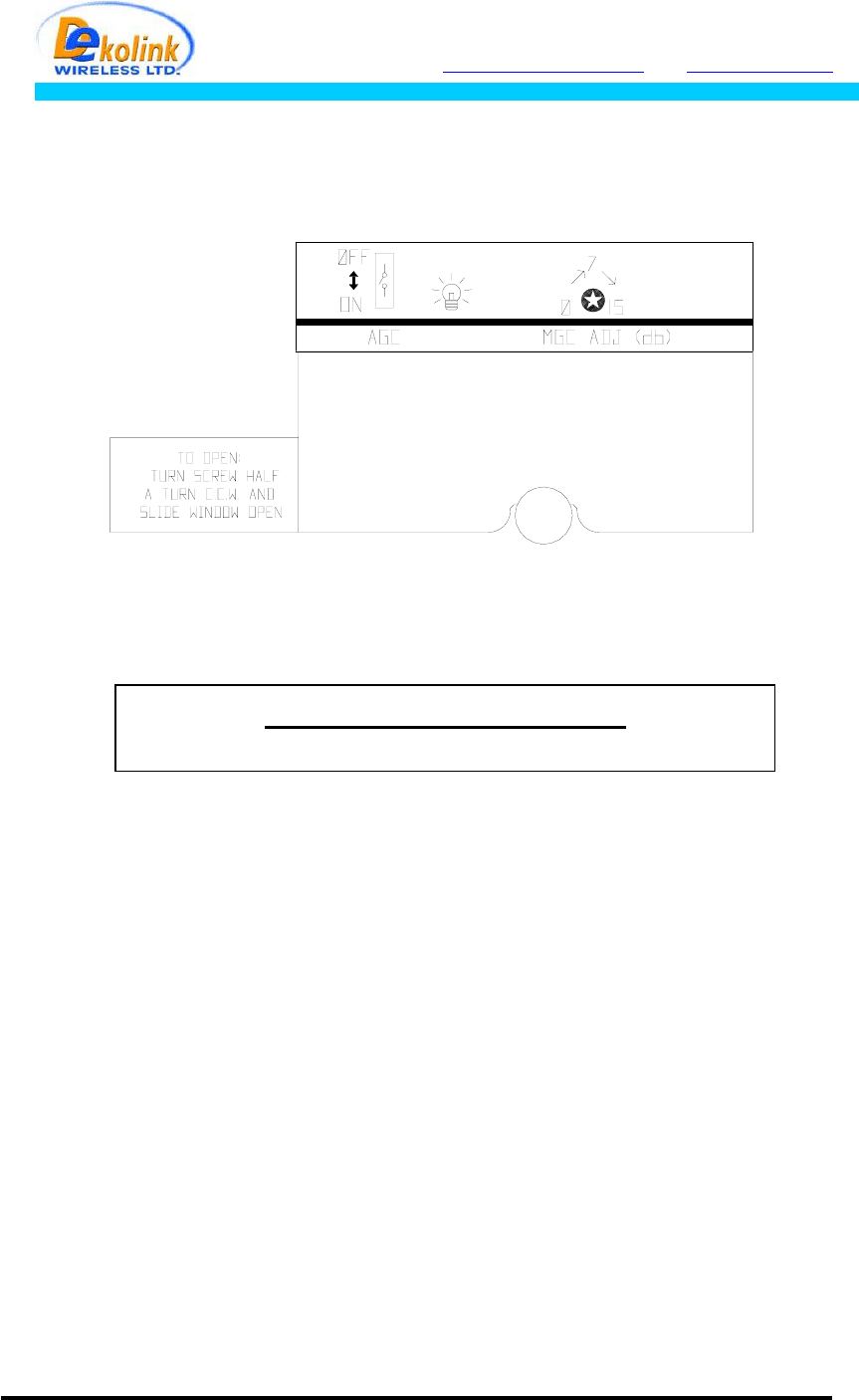
Dekolink WIRELESS Ltd.
16 Bazel St. Qiryat-Arieh Petah-Tikva, Israel, 49510
Tel- 972-3-9180-180 Fax-972-3- 190-9180
e-mail: marketing@dekolink.com web www.dekolink.com
Page 6 of 13 CBDA-800A-1W60-PG2 INST2.doc REV. 0 09.03
Gain Control
Trimmer
(MGC)
Power
Out
LED
AGC
Enable
Switch
AGC & MGC CONTROL
(Control Window Located at BDA sides)

Dekolink WIRELESS Ltd.
16 Bazel St. Qiryat-Arieh Petah-Tikva, Israel, 49510
Tel- 972-3-9180-180 Fax-972-3- 190-9180
e-mail: marketing@dekolink.com web www.dekolink.com
BDA INSTALLATION
Install the BDA Repeater in a shielded, ventilated and easy to reach area. Use low loss cables to
connect antennas to the BDA. Install the BDA close to the service area to improve output power and
noise figure. Mount the BDA with RF connecters pointing down. The RF connection is made via two
type “N” female connectors. The RF connector labeled “Base” must be connected to the antenna;
usually a Yagi; pointing to the base station. The RF connection labeled “Mobile” must be connected to
the antenna pointing into the area to be covered by the BDA.
BASE / DONOR ANTENNA INSTALLATION
Typically this is a directional antenna such as Yagi or Dish antenna of 10 to 15 dB gain. This antenna is
pointed to the base station to get maximum input power. This antenna should be in line of sight with the
base site. Raise this antenna higher if no line of sight is achieved. The required Base signals should be
the dominant signals; at least 6 dB higher power than other signals.
Choose the antenna site to get the maximum isolation from the remote (mobile serving) antenna.
REMOTE / SERVICE ANTENNA INSTALLATION
The remote antenna is an Omni antenna or a directional antenna according to the coverage
requirements.
For indoor applications covering a large building, the RF signals are split using power dividers and
distributed to many antennas each covering a floor or a small area.
ANTENNA ISOLATION
For proper operation the isolation between these two antennas must be at least 12 dB higher than the
BDA gain. Lower isolation would lead to high in-band ripple. Oscillations will build up when the isolation
is lower than BDA gain.
The isolation between the antennas is critical for high gain outdoor repeaters.
To measure the isolation; inject a known signal into one antenna and measure the power at the other
antenna. This should be done across the frequency range of both uplink and downlink bands.
Page 7 of 13 CBDA-800A-1W60-PG2 INST2.doc REV. 0 09.03

Dekolink WIRELESS Ltd.
16 Bazel St. Qiryat-Arieh Petah-Tikva, Israel, 49510
Tel- 972-3-9180-180 Fax-972-3- 190-9180
e-mail: marketing@dekolink.com web www.dekolink.com
INSTALLATION STEPS
1. Install all antennas and connect them to the BDA inputs.
2. Open the access windows at the sides of the BDA so that the variable attenuator is reached and the
LED is visible.
3. Turn the AGC On. This AGC limits the output power of the BDA. The AGC on the Downlink path
guarantees constant downlink power when and if the Donor power changes.
4. Set downlink gain to minimum; uplink gain to minimum ( by turning the gain control trimmer
clockwise).
5. Increase the downlink channel gain (by turning the gain control trimmer counterclockwise) till the
LED turns from off to on. This is the best gain setting giving highest usable power.
6. The LED on the downlink power amplifier will illuminate if adequate donor power has reached the
BDA. If the donor power is low the LED will not lit and the BDA usable power is not used efficiently.
7. Set the uplink gain to the same as the downlink gain.
8. Check that the uplink LED on the BDA monitor does not lit permanently. This LED would lit
permanently If the isolation between antennas is low (BDA oscillations) or the BDA is faulty.
9. If the uplink LED light permanently then:
• Disconnect one of the cables from the BDA connectors and connect a load at the
connectors.
• If the LED on this amplifier illuminates permanently then the BDA is faulty (oscillating) and
needs replacing.
• If the LEDs stops illuminating then the isolation between the donor and remote antennas is
low. Either improve the isolation (e.g. increase separation) or reduce BDA gain.
• To reduce gain, reconnect the antenna cables. Reduce the gain at both uplink and downlink
path until this LED stops illuminating. Reduce the gain further by 10 dB. This is the
maximum usable gain.
Page 8 of 13 CBDA-800A-1W60-PG2 INST2.doc REV. 0 09.03

Dekolink WIRELESS Ltd.
16 Bazel St. Qiryat-Arieh Petah-Tikva, Israel, 49510
Tel- 972-3-9180-180 Fax-972-3- 190-9180
e-mail: marketing@dekolink.com web www.dekolink.com
DIAGNOSTICS GUIDE
The BDA provides long term, carefree operation and requires no periodic maintenance.
This section covers possible problems related to the installation environment.
RF Faults and RF Power Amplifiers LED Indications
The LEDs on the power amplifier are set to turn on when the transmitted power has reached
or exceeded the specified composite power.
Normally the LED at the downlink power amplifier should be on indicating good forward power
transmission. The LED on the uplink power amplifier turns on only when a near by mobile is
transmitting.
Indication Cause Action
Downlink LED does
not light
Indicates low RF power at
downlink path
Check base antenna connection
Check antenna alignment to base.
Use higher gain BDA
Downlink LED lights
(This is not a fault)
Indicates good power
transmission in the downlink
amplifier.
Make sure the amplifier is
not overloaded
Turn AGC on, or reduce gain so that LED
just turns from off to on.
Set the same gain for the uplink channel
Uplink LED lights all
the time
Bad antenna isolation
causing the repeater system
to oscillate
Improve the isolation between the
antennas or reduce RF gain. To verify
disconnect one RF port; LED should turn
off
Uplink LED lights all
the time
Faulty system. Can be
diplexer or power amplifier
fault
System fault. To verify disconnect one RF
port to verify. If LED remains on then
system is faulty.
Excessive
intermodulation or
spurious
Amplifier oscillation caused
by insufficient isolation
Improve the isolation between the
antennas or reduce RF gain.
Excessive noise in
downlink
High input power causing
amplifier overload
Turn AGC on, or reduce gain so that LED
just turns from off to on. Set the same
gain for the uplink channel
Page 9 of 13 CBDA-800A-1W60-PG2 INST2.doc REV. 0 09.03

Dekolink WIRELESS Ltd.
16 Bazel St. Qiryat-Arieh Petah-Tikva, Israel, 49510
Tel- 972-3-9180-180 Fax-972-3- 190-9180
e-mail: marketing@dekolink.com web www.dekolink.com
ELECTRICAL SPECIFICATIONS:
Frequency Range Up Link : 898 – 904 MHz
Down Link : 929-942 MHz
Passband Gain @ min attenuation 60 dB minimum
Passband Ripple ±1.5 dB typical
Output Power AGC Set * +27 dBm nom.
AGC Dynamic Range 30 dB min
MGC (Manual Gain Control) Dynamic Range 15 dB min
Noise Figure @+25°C at max gain 6.0 dB max
3rd Order Intercept point +45 dBm typical
IMD @2 tone @+20 dBm/carrier 50 dBc typical
Spurious @ 27dBm output power
(two tone, 24dBm each)
< -13dBm
Isolation between Up/Down Link 75 dB min
Impedance Level 50 Ohms
VSWR 1.5 : 1 max
Power Supply 80 to 240 VAC; 50 to 60 Hz; @500 mA
*note: AGC preset level can be factory modified to +24dBm upon customer request.
MECHANICAL SPECIFICATIONS:
Size : 10 x 10 x 5 inch approx.
(250 x 250 x 120 mm approx.)
RF Connectors : N-type Female
Weight : 15 Lbs. (7 kg.) approx.
ENVIRONMENTAL CONDITIONS:
The unit is designed for indoor applications:
Operating temperature : - 30°C to + 50°C
Storage temperature : - 50°C to + 80°C
Page 10 of 13 CBDA-800A-1W60-PG2 INST2.doc REV. 0 09.03

Dekolink WIRELESS Ltd.
16 Bazel St. Qiryat-Arieh Petah-Tikva, Israel, 49510
Tel- 972-3-9180-180 Fax-972-3- 190-9180
e-mail: marketing@dekolink.com web www.dekolink.com
RF EXPOSURE WARNING
In order to satisfy the FCC RF exposure requirements, you must ensure that the installation complies
with the following:
One antenna is connected via cable that has typical 1~10 dB attenuation (depends on the length of the
cable) to the BDA BASE port. This antenna is installed outdoor by fixed mounting, and has very sharp
beam (Yagi type or similar) pointed to the donor (BTS). This type of antenna has up to 15 dBi gain.
Typical specifications: gain: 15 dBd (=10.1 dBi), VSWR: better than 1.5:1 , Impedance: 50 ohm. The
outdoor antenna must be installed to provide a minimum separation distance of 0.5 m (50 cm) from
persons within the area.
The second antenna is connected via cable that has typical 1~10 dB attenuation (depends on the length
of the cable) to the CBDA MOBILE port. This type of antenna is omnidirecttional (isotropic), or wide
beam, with 0 to 2 dBi typical gain and is installed and distributes indoor (in buildings, tunnels,
basements, park lots, shopping centers etc.). Typical specifications: gain: 2 dBi, VSWR: better than 2:1 ,
Impedance: 50 ohm. The indoor antenna must be installed to provide a minimum separation distance of
0.2 m (20 cm) from persons within the area.
Page 11 of 13 CBDA-800A-1W60-PG2 INST2.doc REV. 0 09.03
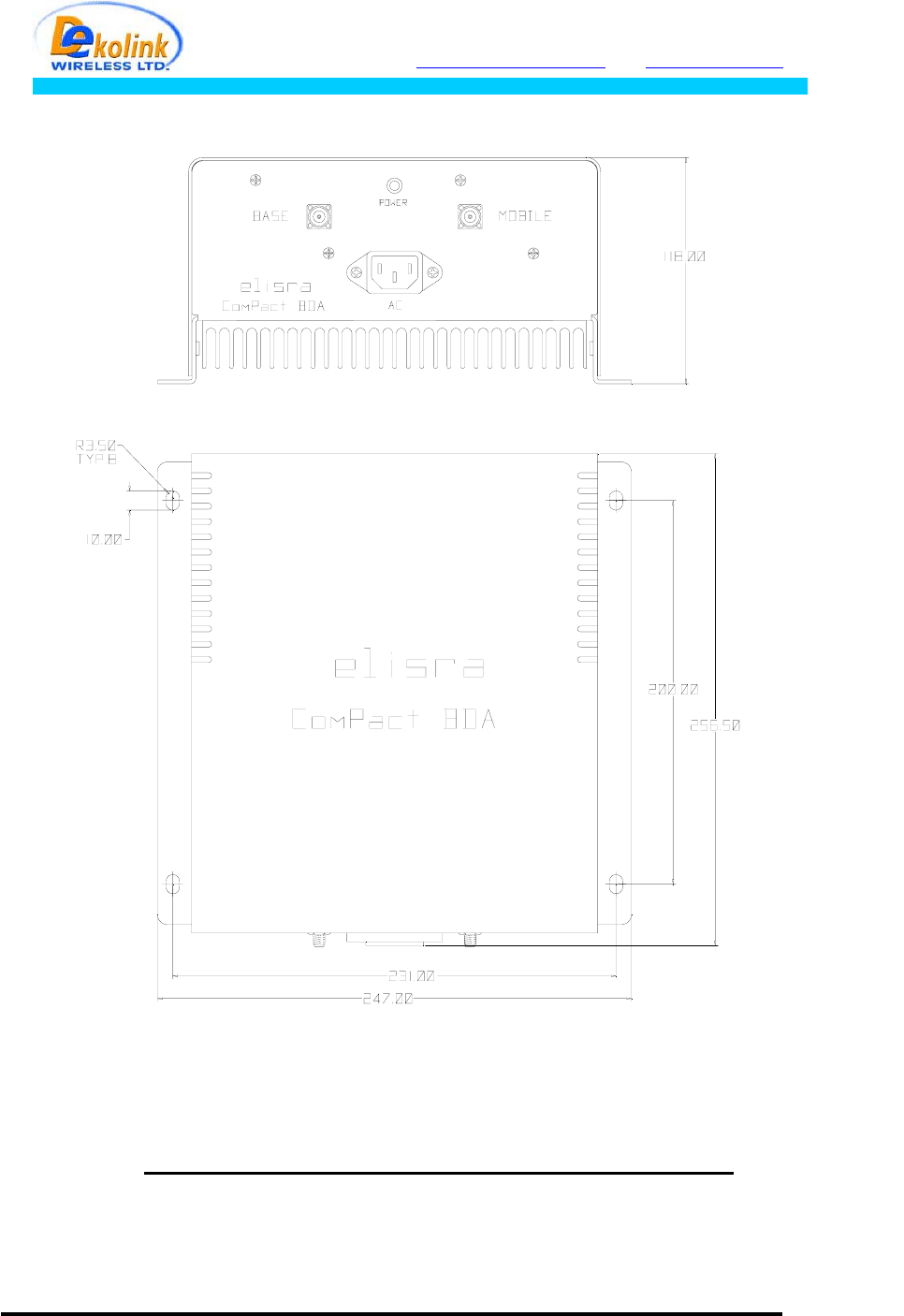
Dekolink WIRELESS Ltd.
16 Bazel St. Qiryat-Arieh Petah-Tikva, Israel, 49510
Tel- 972-3-9180-180 Fax-972-3- 190-9180
e-mail: marketing@dekolink.com web www.dekolink.com
MECHANICAL OUTLINE
Page 12 of 13 CBDA-800A-1W60-PG2 INST2.doc REV. 0 09.03

Dekolink WIRELESS Ltd.
16 Bazel St. Qiryat-Arieh Petah-Tikva, Israel, 49510
Tel- 972-3-9180-180 Fax-972-3- 190-9180
e-mail: marketing@dekolink.com web www.dekolink.com
LIMITED WARRANTY
Dekolink Wireless [Ltd.] (“Dekolink”), manufacturer of this product (the “Product”) warrants to
the original purchaser (“Purchaser”) that the Product is free from defects in materials and
workmanship for a term that ends on the earlier of twelve (12) months from the date of
activation of the Product or fifteen (15) months from the date of shipment of the Product by
Dekolink. The obligations of Dekolink under this warranty shall be limited solely to the repair or
exchange or giving credit for, at the option of Dekolink, any Product that may prove defective in
accordance with evidence satisfactory to Dekolink. Any repair or replacement of the Product by
Dekolink shall not extend the original warranty period. This warranty is exclusive to the original
Purchaser and is not assignable.
This warranty applies only upon the condition that the Product has been installed, maintained and
operated under conditions of normal use. The provisions of this warranty shall not apply if, in
Dekolink’s judgment, the Product has been subject to misuse or neglect, damaged in an accident or
by act of vandalism, or repaired or altered in any way that adversely affects its performance or
reliability.
To obtain warranty service, Purchaser may, upon the prior written authorization of Dekolink or its
authorized service representative, return the defective Product to Dekolink’s authorized service
center. All shipping and insurance charges are the sole responsibility of Purchaser and are not
included in this warranty.
Dekolink expressly excludes and disclaims all other warranties, including but not limited to any
warranties of merchantability or fitness for a particular purpose.
Dekolink shall in no event be liable for any special, indirect, incidental, consequential or punitive
damages or for loss, damage, or expense, including loss of use, profits, revenue, or goodwill,
directly or indirectly arising from purchaser’s use or inability to use the merchandise, or for loss
or destruction of other property or from any other cause, even if Dekolink has been advised of
the possibility of such damage. Some states do not allow the exclusion or limitation of incidental
or consequential damages so these limitations may not apply under certain circumstances.
The liability of Dekolink shall in no event exceed an amount equivalent to the purchase price paid
by the purchaser for the defective product.
This warranty shall not be extended, altered or varied except by a written instrument duly signed
by Dekolink.
Page 13 of 13 CBDA-800A-1W60-PG2 INST2.doc REV. 0 09.03